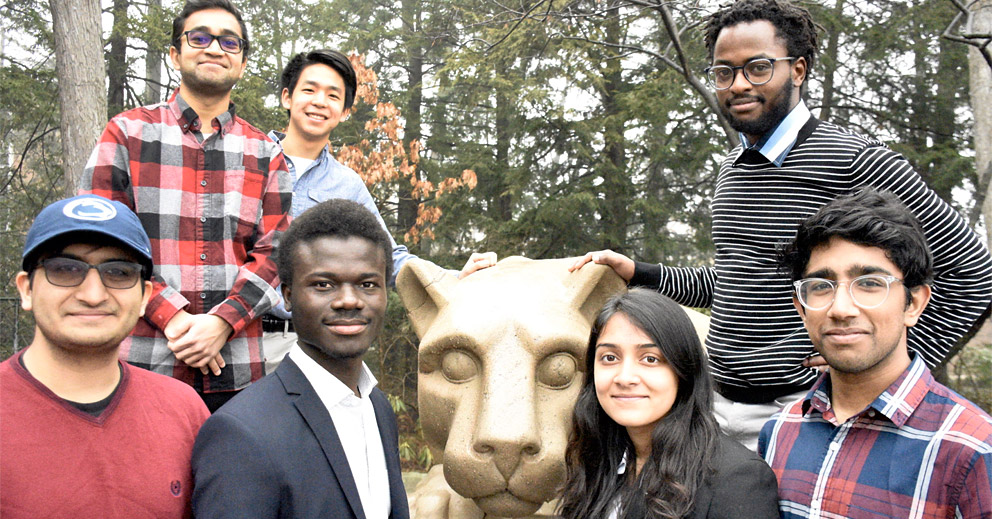
I am known for speaking loudly and often about the amazing qualities of our students and reviewers, but never have these attributes been more on display than within this period of uncertainty and flux we are all facing due to COVID-19. The top twenty teams competing in the Nittany AI Challenge spent months developing prototypes to present to a team of judges, but because of the restrictions on public events put in place to protect everyone’s safety, all in-person meetings and presentations were canceled. In true Penn State spirit, the teams worked with us to adapt the entire process to an online format that would maintain both the integrity of the reviews and the dynamic, engaging conversations that typically occur between the reviewers and the teams. The students demonstrated drive, determination, professionalism, and compassion throughout the changes — nimbly adapting their plans and making the best of the new opportunities a virtual environment would afford them. The reviewers, in turn, dedicated many extra hours of their time to deeply engage our students through online discussions and videos. Each and every individual involved in the process embodied the best of our community.
To overcome the physical distance between team members, reviewers, and those of us advising the teams, I looked first to the amazing suite of tools already available to us through Penn State. The Adobe Suite available through our Penn State license is built around collaboration and allowed a number of teams to transition seamlessly to a completely virtual and asynchronous workflow. Adobe XD, in particular, helped multiple teams build their user interfaces. Adobe Premier assisted teams in creating demo videos to replace the originally planned live demos, and, while having a steep learning curve, allowed the teams to create professional looking videos using just their laptops.
We had already leveraged Microsoft Teams to facilitate announcements and some communication, but it also seemed to be a fantastic tool for replicating the engaging back and forth dialog that is the hallmark of our review events. That hunch proved out, as the final summary document of the Q&A that transpired between teams and the reviewers was over 45,000 words and consisted of 93 pages of engaging, insightful comments and dialog.
And of course, there is Zoom, the current backbone of our regular meetings and the way most of our teams are staying in communication with each other. While chat and email are valuable, there is nothing that compares to being able to see each other’s faces and give a well-timed stare when someone on the team is not hitting their deadlines.
While these tools provided by Penn State are crucial, there are a few areas where outside tools have proven valuable. From Trello to GitHub, Figma to Tableau, there are a large number of specialized tools offering free access to students that are being leveraged by our Challenge teams. To that end, we have begun compiling an open and living list of these resources available to anyone interested at https://bit.ly/ChallengeTools. It is regularly updated with new resources that come my way.
The cumulative effect of these tools has been to both help our teams create amazing prototypes focused on applying AI to improve their world and make certain that we are able to provide a first-class, engaging review process.
At the start of the Nittany AI Challenge in January, student teams were invited to submit their ideas to use AI for Good and improve the world by providing solutions for problems within the areas of education, health, humanitarian challenges, sustainability, and climate change. Twenty teams were selected in the first round and were required to create a prototype. Out of the prototypes submitted, ten teams have been chosen by the panel of reviewers to receive $1,500, move to the final round, and build a minimum viable product (MVP) for a chance at a $25,000 prize pool. The selected teams represent Penn State Berks, Great Valley, Harrisburg, and University Park campuses and their members are enrolled in the Donald P. Bellisario College of Communications; the Colleges of Earth and Mineral Sciences, Education, Engineering, Health and Human Development, and Information Sciences and Technology; Smeal College of Business; The Capital College; and the College of the Liberal Arts at Penn State.
- AI Guide: using AI to help the visually impaired navigate indoors and find objects
- Aidly: using AI to assist nonprofits in volunteer outreach
- Bloom: connecting farmers to wholesalers in developing countries
- COACT: Cowriting Optimized and Ascended Clinical Trials
- Cyclone: using smart technology to reduce large-scale energy waste in buildings
- Energy Intelligence: reducing energy use by regulating heating, cooling, and lighting systems
- MedArmor: producing genetic and AI–based diagnoses and medical cost estimation
- Nyansapo: increasing literacy rates in African countries
- UAS Search and Rescue: using object detection to predict locations of lost hikers from aerial imagery
- Vessel: building 3-D vascular network models to detect tumors and advance artificial tissue growth
Each of the selected teams is invited to submit their MVP in August. The MVP review, awards, and celebration are scheduled for September 10, 2020, on the Penn State University Park campus.
